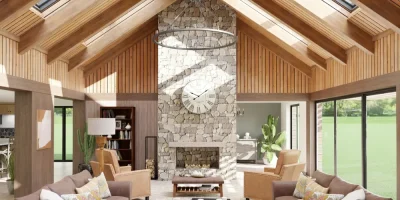In today’s competitive market, the design and efficiency of commercial spaces are more crucial than ever. Businesses are looking for innovative ways to maximize their space, improve productivity and create environments that foster collaboration and well-being.
As a designer or builder, you need to provide your commercial clients with a clear path to optimizing their space. In this 7-minute read, we’ll give you professional tips for doing just that.
So let’s explore practical strategies for optimizing commercial spaces, from multifunctional areas to cutting-edge design technologies. Apply these to your commercial design projects and you’ll impress your clients and land more jobs.
Let’s start with why efficiency is such an important consideration for commercial spaces.
The Importance of Space Efficiency in Commercial Spaces
Space efficiency is not just about cramming as much as possible into a given area. It’s about using space intelligently to boost productivity, improve employee satisfaction and reduce costs.
According to the World Green Building Council, businesses can see major increases in employee health, wellbeing and productivity by optimizing their workspace design.
So it’s proven that effective use of space in commercial settings can lead to numerous benefits, including:
- Enhanced Productivity: Well-organized spaces reduce distractions and make it easier for employees to focus on their tasks.
- Employee Satisfaction: Comfortable and flexible work environments can boost morale and job satisfaction.
- Cost Savings: Efficient use of space can reduce the need for additional real estate, which lowers overhead costs.
- Sustainability: Optimized layouts can minimize energy consumption and waste,
- Adaptability: Flexible spaces can quickly adapt to changing business needs. This ensures long-term utility.
Check out the next section for optimization tips that can help your clients reap the benefits of well-designed commercial spaces.
Strategies for Optimizing Commercial Spaces
To make the most of your client’s commercial space, consider implementing these innovative strategies.
1. Multifunctional Spaces
About this strategy: Multifunctional spaces are designed to serve multiple purposes within a single area. This strategy maximizes the utility and adaptability of the space. These areas can transition from one function to another, such as a meeting room that doubles as a break area or a collaborative workspace. The key to multifunctional spaces is flexibility through the use of furniture, partitions and tech that adapts to various needs throughout the day.
Tips for implementing this strategy:
- Modular Furniture: Use furniture that can be easily reconfigured to suit different activities.
- Flexible Partitions: Install movable walls or partitions to quickly change the room layout.
- Smart Storage Solutions: Incorporate storage that blends with the decor to keep the space clutter-free.
2. Natural Light & Biophilic Design
About this strategy: Integrating natural light and elements of nature into your design, known as biophilic design, can significantly enhance the well-being and productivity of occupants. Biophilic design incorporates natural elements such as plants, natural light, water features and natural materials. Studies have shown that exposure to natural elements can reduce stress, increase creativity and improve overall mental health.
Tips for implementing this strategy:
- Maximize Windows: Ensure windows are unobstructed. Use reflective surfaces to enhance natural light.
- Indoor Plants: Add greenery to improve air quality and create a calming atmosphere.
- Natural Materials: Use materials like wood and stone to bring nature indoors.
PRO TIP! – Want to show your clients how their space will look with realistic natural lighting effects? Use Cedreo 3D design software to create photorealistic views of their commercial space with a variety of lighting effects, including natural lighting based on the sun’s location and building position.
3. Acoustics Management
About this strategy: Managing acoustics in commercial spaces is vital for creating a productive and comfortable work environment. Poor acoustics can lead to distractions, decreased productivity and increased stress levels among employees. Effective acoustics management should control noise levels and improve sound quality through strategic design and material choices.
Tips for implementing this strategy:
- Sound-Absorbing Materials: Use acoustic panels, carpets and ceiling tiles that absorb sound to reduce noise levels.
- Strategic Placement: Position noise-generating equipment like printers and HVAC systems away from workstations and meeting areas.
- Sound Barriers: Install partitions or soundproof glass walls between different zones to minimize noise transfer while maintaining an open feel.
4. Open Floor Plans & Intentional Traffic Flow
About this strategy: Open floor plans enhance collaboration and communication by removing physical barriers between employees. Intentional traffic flow ensures that movement within the space is efficient and intuitive. An open floor plan with intentional traffic flow creates a dynamic and fluid workspace where employees can easily interact and move between different zones.
Tips for implementing this strategy:
- Zoning: Define areas for different activities (e.g., collaborative zones, quiet areas).
- Wayfinding: Use visual cues like colors and signs to guide movement.
- Furniture Placement: Arrange furniture to facilitate easy navigation and interaction.
5. Utilize Vertical Space
About this strategy: Vertical space utilization involves making use of walls and height to increase storage and functionality. This approach is especially useful in smaller commercial spaces where floor space is limited. By thinking vertically, businesses can maximize their storage capacity and keep the workspace organized and efficient.
Tips for implementing this strategy:
- Shelving Units: Install shelves and cabinets that go up to the ceiling.
- Wall-Mounted Desks: Use wall-mounted desks and workstations to free up floor space.
- Hanging Storage: Use hooks and racks for hanging storage solutions.
6. Data-Driven Decisions
About this strategy: Data-driven design uses data analytics to inform decisions about space utilization. By collecting and analyzing data on how spaces are used, businesses can identify inefficiencies and make informed adjustments. This approach ensures that every square foot of the commercial space is used effectively.
Tips for implementing this strategy:
- Space Utilization Sensors: Install sensors to monitor how space is used and identify underutilized areas.
- Employee Feedback: Regularly collect feedback to understand how spaces are being used.
- Adjust Based on Data: Use the data collected to make informed adjustments to the layout.
7. Collaborative Work Spaces
About this strategy: Collaborative workspaces are designed to facilitate teamwork and enhance creativity. These areas are typically equipped with technology and furniture that support group work and brainstorming sessions.
Tips for implementing this strategy:
- Dedicated Zones: Create dedicated zones for group work.
- Tech Integration: Ensure these areas are equipped with the latest collaboration technology.
- Comfortable Seating: Provide comfortable and varied seating options to encourage longer and more productive meetings.
8. Future-Proof Design
About this strategy: Future-proof design ensures that your client’s commercial space remains functional and relevant over time. This involves designing spaces that can adapt to changing needs and technologies.
Tips for implementing this strategy:
- Modular Elements: Use modular elements that can be easily upgraded or replaced.
- Flexible Infrastructure: Incorporate flexible infrastructure like raised floors for easy access to cabling.
9. Space Utilization Technologies
About this strategy: Leveraging technology to monitor and optimize space utilization can significantly improve efficiency. Space utilization technologies include IoT devices, smart HVAC systems and space management software. These technologies provide real-time data on how spaces are used, allowing for dynamic adjustments and optimizations.
Tips for implementing this strategy:
- IoT Devices: Use Internet of Things (IoT) devices to track space usage.
- Smart HVAC Systems: Implement smart HVAC systems to optimize climate control based on occupancy.
- Space Management Software: Utilize software to manage and schedule space allocation while tracking utilization trends.
Start Designing Today!
If you work with commercial clients, you need to stay up to date with the latest ways to optimize commercial spaces for efficiency. That lets you create business environments that are more efficient, productive and enjoyable.
Cedreo software can help you design these optimized spaces with ease.
- 3D Visualization: Create realistic 3D visualizations to show clients their commercial space before the project even starts.
- Easy Modifications: Quickly make changes to your design and see the results instantly.
- Collaboration Tools: Share your designs with clients and team members for seamless collaboration.
- Comprehensive Library: Access a vast library of furnishings and fixtures to customize your client’s space.
With a FREE version, you’ve got nothing to lose. Sign up for Cedreo today!



